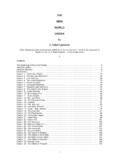Transcription of Beyond IF THEN ELSE: Techniques for Conditional ... - SAS
1 1 Paper 326-2017 Beyond IF THEN ELSE: Techniques for Conditional Execution of SAS Code Joshua M. Horstman, Nested Loop Consulting, Indianapolis, IN ABSTRACT Nearly every SAS program includes logic that causes certain code to be executed only when specific conditions are met. This is commonly done using the syntax . In this paper , we will explore various ways to construct Conditional SAS logic, including some that may provide advantages over the IF statement. Topics will include the SELECT statement, the IFC and IFN functions, the CHOOSE and WHICH families of functions, as well as some more esoteric methods.
2 We ll also make sure we understand the difference between a regular IF and the %IF macro statement. INTRODUCTION The Conditional execution of code is one of the most fundamental concepts in computer programming of all types. The ability to take different actions based on different inputs is essential to the completion of complex tasks. Indeed, most SAS programs are chock full of Conditional logic. The most common method for implementing Conditional logic using SAS software, and probably the first learned by most SAS programmers, is the statement.
3 This construct provides a simple means of branching the flow of execution based on whether a specified condition is true or false. However, there are many other Techniques available to the SAS programmer. We will examine several of them in this paper, study examples of their use , and consider what advantages they may offer over the statement. THE SELECT STATEMENT One alternative to the statement is the SELECT statement. The SELECT statement is always used in conjunction with a group of one or more WHEN statements.
4 This structure can operate in one of two ways. The first and most common way to use the SELECT statement is to specify an expression as part of the SELECT statement. That expression is compared to the WHEN expression(s) associated with each WHEN statement. (A WHEN statement can have more than one WHEN expression.) When a WHEN expression is encountered that is equal to the SELECT expression, the statement associated with that WHEN expression is executed. Once such a WHEN expression is found, no further WHEN expressions are tested, and execution of the SELECT/WHEN block ends.
5 An optional OTHERWISE statement can specify code to be executed if none of the WHEN expressions match the SELECT expression. The second, less common way to use the SELECT statement is without a SELECT expression. In this case, each WHEN expression is simply evaluated as true or false. The statement associated with the firs t true WHEN expression, i f any, is executed. I f none of the WHEN expressions evaluate to true, the OTHERWISE statement, if present, is executed. EXAMPLE #1 USING Consider the following example written with traditional syntax.
6 This code computes a total price which varies depending on the type of customer. Everyone starts with the base price, but some customer types receive a discount. Additionally, certain customer types pay sales tax while others do not. if customer_type = 'STANDARD' then total = price * taxrate; else if customer_type = 'PREFERRED' then total = price * discount * taxrate; else if customer_type = 'TAXEXEMPT' then total = price; else if customer_type = 'GOVERNMENT' then total = price * discount; 2 EXAMPLE #1 USING THE SELECT STATEMENT The same logic can be implemented using the SELECT statement as follows: select(customer_type); when('STANDARD') total = price * taxrate; when('PREFERRED') total = price * discount * taxrate.
7 When('TAXEXEMPT') total = price; when('GOVERNMENT') total = price * discount; end; While these two methods produce the same result, the structure of the SELECT statement is more readily apparent at a glance, making it easier to read, debug, modify, and reuse. THE IFC AND IFN FUNCTIONS Conditional logic can also be implemented using the IFC and IFN functions, which were new in version 9 of the SAS software. In certain situations, these functions can produce a much more compact and elegant alternative to logic.
8 Both functions accept the same four arguments: a logical expression to be tested, a value to be returned if the expression is true, a value to be returned if the expression is false, and, optionally, a value to be returned if the expression is missing. The difference between the two functions is that IFC returns a character value while IFN returns a numeric value. EXAMPLE #1 USING THE IFN FUNCTION Consider the following alternative way to code the example discussed above. total = price * ifn(customer_type in ('PREFERRED','GOVERNMENT'),discount,1) * ifn(customer_type in ('STANDARD','PREFERRED'),taxrate,1); This single assignment statement replaces an entire block of logic, while simultaneously making the underlying logic behind the derivation of TOTAL more clear.
9 In each call to the IFN function, if the expression is false, we have cleverly returned a value of 1, which will have no effect when used as a factor in multiplication. EXAMPLE #2 USING THE IFC FUNCTION The IFC function can be particularly useful when building strings consisting of multiple components determined by various pieces of Conditional logic. Consider the example below. We wish to construct a text string for a report which will indicate a subject s marital status and number of children. First look at the code written using a series of statements.
10 Notice that a separate statement is included for each of several different cases that may occur. if married='Y' and num_kids=0 then family_status = 'Married, no children'; if married='N' and num_kids=0 then family_status = 'Unmarried, no children'; if married='Y' and num_kids=1 then family_status = 'Married, 1 child'; if married='N' and num_kids=1 then family_status = 'Unmarried, 1 child'; if married='Y' and num_kids>1 then family_status = 'Married, '|| strip(put(num_kids,best.))||' children'; if married='N' and num_kids>1 then family_status = 'Unmarried, '|| strip(put(num_kids,best.))











